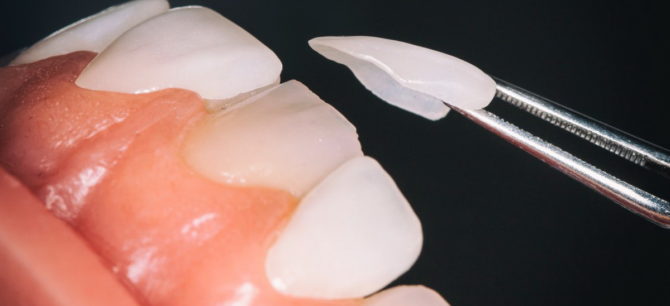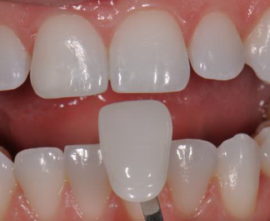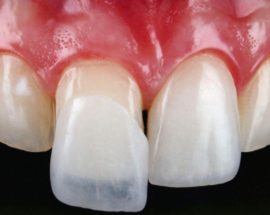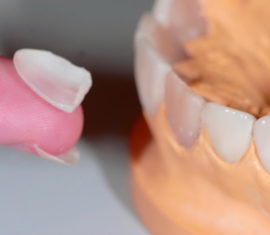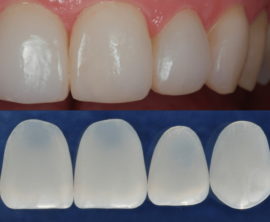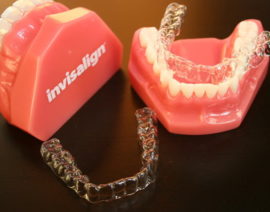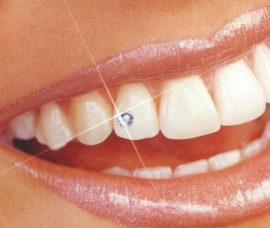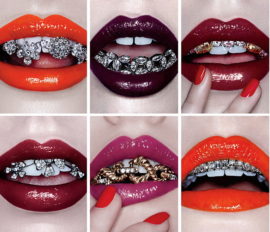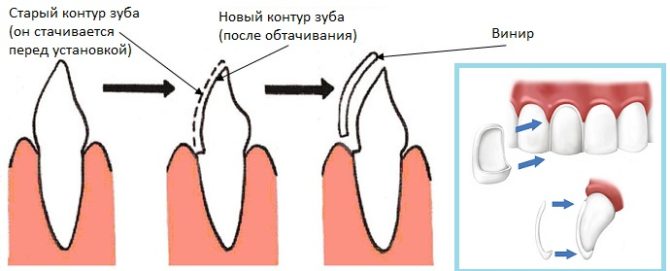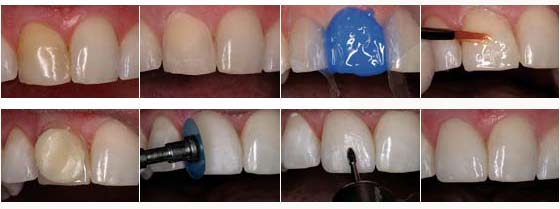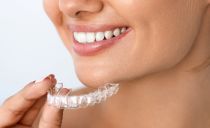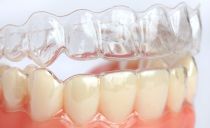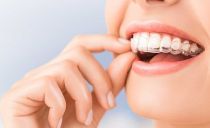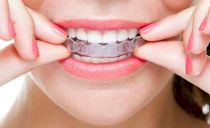Teeth pads: what are they and what are they called
To improve the aesthetics of a smile, ceramic, metal and many other tooth pads are used. They allow you to correct defects in the dentition or simply create a special image. Different types of linings have an individual purpose, features of installation and use.
Content
Why do I need tooth pads?
Teeth pads provide an opportunity to solve various dental problems, depending on the purpose of the installation they are divided into:
- Therapeutic - are used to eliminate defects on the surface of the teeth. Are established at cracks on enamel, a thin enamel layer, the irregular shape of teeth, too wide interdental spaces. The service life of such products is up to five years.
- Orthopedic - are placed to align the dentition. Budget orthopedic designs can retain their properties for up to 10-12 years, expensive lumineers - up to 20 years.
- Decorative - used as decoration. They do not have a specific service life. There are removable and non-removable decorative designs, made to order or standard stamped.
What are the names and set of tooth pads
In the variety of tooth pads that are installed in modern dentistry, it is easy to get confused. Their assortment is increasing all the time, but at the moment the most popular are the following types of lining:
| Title | Destination | Production material |
|---|---|---|
|
Veneers |
Improving the aesthetics of a smile, correcting minor defects of teeth. | Ceramics, composite materials, zirconium. |
|
Lumineers |
Improving the shade of teeth, correcting minor defects in enamel. | China. |
|
Ultranirs |
Improving the aesthetics of a smile, correcting small defects in enamel. | Heavy-duty pressed ceramics. |
|
Composers |
Elimination of small aesthetic problems with teeth, including a wedge-shaped defect. | Nanohybrid composite. |
|
Capa |
Removable pads for whitening, aligning teeth. | Silicone, polyurethane. |
|
Skyes |
Decorative pads in the form of rhinestones glued to the tooth for beauty. They can mask minor defects. | Artificial diamonds, precious stones and metals. |
|
Grills |
Removable decorative tooth pads in the form of complex jewelry. | Precious metals, alloys, precious stones. The base is made of silicone. |
Installing ceramic tooth pads
Ceramic tooth pads include veneers made of porcelain and zirconium, ultniri and lumineers.
Ceramic veneers have the largest thickness (about 0.7 mm), ultra-veneers - medium (up to 0.5 mm), lumineers - the smallest (up to 0.3 mm). Due to the difference in thickness, there are differences in the installation of these products: only the finest lumineers are placed on unfinished teeth, the installation of other types of ceramic overlays requires preliminary grinding of enamel.
It will take about a week to fully install ceramic false teeth, during which you will have to visit the dentist at least twice:
- At the first appointment, the doctor assesses the condition of the teeth and oral cavity.
- If the doctor detects an inflammatory process in the oral cavity or caries, treatment is performed.If contraindications to the installation of veneers, lumineers and ultranirs are not found, the dentist and patient select the optimal type of lining for the teeth, choose the material for its manufacture, the color suitable for the shade of the remaining teeth.
- The tooth is processed, the top layer of enamel is ground (if necessary).
- An imprint of the jaw is created.
- A temporary overlay is put on the treated tooth, which protects its internal tissues from damage.
- A permanent patch is made within a few days.
- During the second visit, the dentist tries on a finished pad. If it is made correctly and does not cause discomfort, it is glued to dental cement.
Install composite pads
Composite veneers are installed in one go. They are made of the same light-cured materials that are used in dentistry for filling. Preliminary grinding of enamel is required only in certain cases. The installation process goes like this:
- The dentist examines the oral cavity for contraindications.
- In the absence of contraindications, the upper enamel layer is polished (if necessary).
- Layers of composite material are applied one after the other to the treated tooth.
- Grind the finished pad, check the closing of the teeth.
Composite pads can be made in the laboratory by polymerizing the material in an oven. Such micro prostheses are of higher quality.
Installation of decorative overlays
Skys are set for beauty as permanent pads that are fixed with dental cement. Pretreatment and grinding of tooth enamel is not required. Sometimes it is necessary to make a recess in enamel, which, after the end of the life of the skyce, is sealed with filling material. You can insert skays into the veneers to simultaneously eliminate defects and to decorate the surface of the dentition.
Removable tooth pads
Grills are called removable tooth pads of various shapes that are worn periodically at home. During meals and at bedtime they are removed. Stamped nozzles can be purchased ready-made, but dentists recommend making individual models in aesthetic dentistry clinics, since they are ideally suited to the dentition of a particular patient.
Cap installation
Caps are called products that can be used to whiten enamel or to align teeth. They are also called eliners. Depending on the method of manufacture and use of the cap, there are:
- Thermoplastic - expanding under the influence of hot water and taking the form of human teeth when cooling.
- Usual - standard mouthguards made in accordance with the average shape and size of the jaw.
- Individual - made according to the cast of the patient’s teeth and used to correct the bite.
With the help of a cap you can eliminate only mild bite defects. In the presence of serious dentition abnormalities, braces are required, after wearing which the eliners can be used to fix the result.
Contraindications to the use of false teeth
Correction and decoration of the dentition with overlays or nozzles is not suitable for everyone. Dentists do not recommend resorting to such procedures when:
- inflammatory dental diseases accompanied by bleeding gums;
- diseases of the nervous system;
- an allergic reaction to the materials used;
- the presence of bad habits - a tendency to gnash your teeth, cracking hard objects and in the absence of proper hygiene skills.
Dental Care
If a person uses toothpads, he must know how to care for them at home. Otherwise, the microprosthesis or decoration will quickly lose its aesthetic properties or break.
Dental care rules:
- After installing the pads in dentistry, you should immediately consult a doctor about all the intricacies of oral care.
- After tooth restoration, it is undesirable to eat very solid foods and viscous products, so as not to damage the pad.
- Food and drinks that have aggressive and coloring properties (wine, coffee, pomegranates) should not be consumed or consumed in minimal quantities.
- You need to regularly brush your teeth and handle removable pads with special solutions that the dentist will recommend.
- Metal nozzles and composite pads need to be polished periodically, since their surface will scratch and tarnish over time.
- Several times a year, you need to visit the dentist to monitor the condition of the oral cavity and the false teeth themselves, as well as professional cleaning of products.
Fixed pads for chewing or front teeth glued to dental cement cannot be removed either at home or in the clinic. If they have deteriorated or broken, you need to restore the tooth by other methods, for example, put a crown on top.
Using false teeth helps a person fix many dental defects and brighten a smile. But the beauty of the dentition is achieved only with the correct installation of structures and careful care of them. Therefore, you need to carefully consider the choice of a dental clinic and the materials used for the manufacture of overlays, and after their installation, hygiene and lifestyle should be followed.

